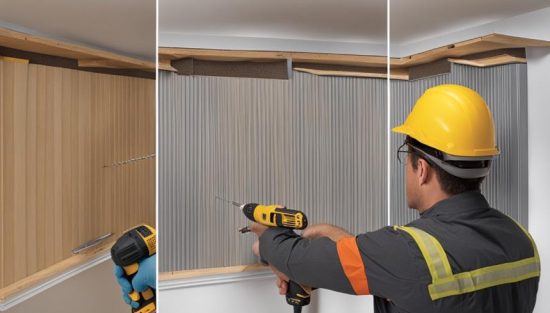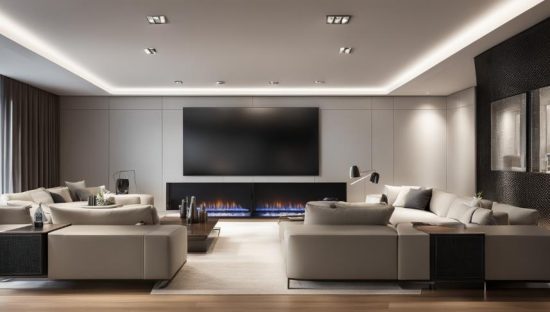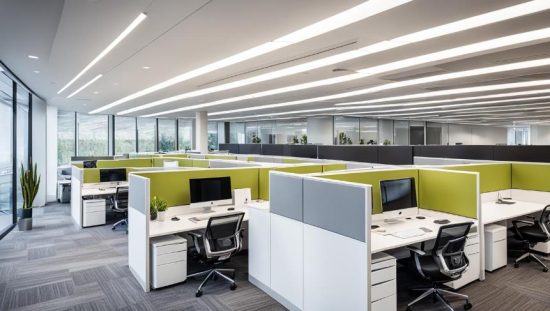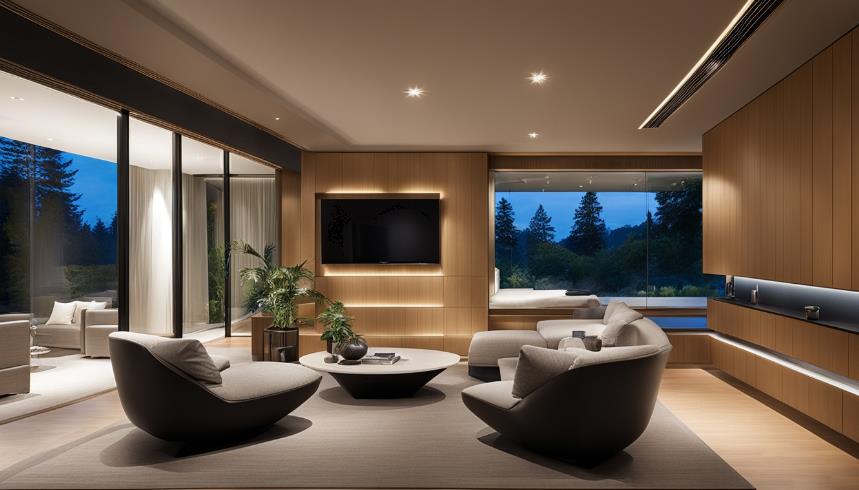Advancements in noise reduction technology have made soundproof panels essential for creating calm environments in busy office spaces. Even a small office room might require a significant area of acoustic panels to manage sound effectively. Products like Versare’s SoundSorb™ and VersaPanel™ lead this revolution with sustainable materials and impressive noise reduction capabilities.
In open office layouts, effective acoustic treatment is crucial to prevent distracting noise buildup. Strategically installing soundproof panels not only improves focus but also enhances room aesthetics, with options available in various colors to blend seamlessly with decor. This can also use in bedrooms to soundproof and get peaceful sleep. These panels exemplify the fusion of functional soundproofing and decorative finesse, ensuring that commercial spaces sound better and look inviting.
How do you soundproof a wall and ceiling with panels?

Soundproofing walls and ceilings is essential for creating quiet, focused environments, involving various materials and techniques. For walls, thick acoustic panels absorb and block sound, often paired with an extra layer of drywall and acoustic caulk to seal gaps. Ceilings benefit from acoustic ceiling panels, including grid-based options and more advanced soundproof panels infused with mass-loaded vinyl. These materials effectively block airborne noise and enhance acoustic quality. Understanding and properly deploying these components ensures a quieter, more focused space.
- Injection Foam: Employing injection foam within wall cavities offers up to 80% reduction in sound transmission.
- Acoustic Ceiling Options: Utilizing high-density ceiling insulation systems, such as the AcoustiClip System, which provide both sound absorption and dampening capabilities.
- Layered Solutions: Combining materials like mass-loaded vinyl between drywall panels or employing dual techniques of decoupling and mass additions enhance overall efficacy.
Each building and room requires a tailored soundproofing approach based on its structure and specific needs, best determined by consulting a professional. Proper installation, including correct placement and securement of panels, is critical to avoid gaps that reduce effectiveness. Choosing the right materials and methods ensures soundproofing aligns with the space’s acoustic challenges and design, enhancing comfort and functionality.
How to install Soundproof panels on walls and ceilings?
Installing soundproof panels is a straightforward process that can significantly enhance the acoustic atmosphere of any space. Whether implemented in a home studio or a bustling office, effectively installing soundproof panels can mitigate reverberations and create a quieter environment. Below we discuss the preferred methods and considerations for acoustic panel installation using the Impaling Clip Method and considerations for using alternative Z-Clip Method.
- Impaling Clip Method: This method is favored for installing AlphaSorb® Fabric Wrapped Acoustic Panels. To start, impaling clips should be placed precisely 4 inches inward from where the edge of the panel will sit. The process is not only efficient but also ensures secure attachment with minimal wall damage.
- Z-Clip Method: Although offering a robust installation, this approach is more time-consuming involving careful measurement and planning. It provides a valuable alternative for circumstances where wall penetrations must be minimized.
Cutting and adjusting acoustic panels requires tools like a tape measure, scissors, a metal square, and a utility knife, allowing for effective customization during installation. Strategic panel placement, maintaining a minimum of 3 inches between panels and considering an air gap behind them, enhances both aesthetic appeal and sound absorption.
Besides the technical aspects of sound dampening panels, various options are available based on the needs of different environments:
- 1″ thickness panels are ideal for residential use, while 2″ panels are better suited for heavy commercial applications.
- The panels are available in 41 colors across 4 fabric lines, allowing customization to match any interior design.
For further technical support or assistance with installation, multiple resources such as contact forms, phone numbers, and detailed installation guides are readily available. These resources ensure that users can effectively tackle any challenges they encounter during the installation process.
| Installation Method | Tools Required | Panel Placement | Time Efficiency |
|---|---|---|---|
| Impaling Clip | Tape measure, Scissors, Metal Square, Utility Knife | 4″ from edges, 3″ apart between panels | High |
| Z-Clip | Power tools (if required) | Measure to fit, Air gap recommended | Moderate |
High-quality soundproof panel brands in the US

In the competitive acoustic solutions market, the United States features top manufacturers offering USA-made acoustic panels known for quality and sustainable processes. Versare’s SoundSorb™ panels, crafted primarily from recycled materials, exemplify this eco-friendly approach. With a high Noise Reduction Coefficient (NRC), these panels effectively blend functionality and design, suitable for both professional and living spaces.
| Brand | Product | NRC Rating | Features |
|---|---|---|---|
| TroyStudio | Thick Acoustic Foam Panels | 0.8 | Good absorbency, versatile use |
| Izo | Egg Crate Foam Acoustic Panels | 0.4 | Budget-friendly, suitable for small spaces |
| Bubos | Decorative Art Acoustic Panels | 0.85 – 0.95 | High performance, decorative designs |
| Auralex | Studiofoam Wedgies | 0.75 | Ideal for studios, effective soundproofing |
| Dekiru | Soundproofing Insulation Panels | 0.92 | High-performance, wide applications |
| Sonic Acoustics | Hexagon Soundproofing Panels | 0.92 | Vibrant colors, high absorption |
How to combine aesthetics and acoustics
In modern interior design, blending aesthetics with superior acoustic functionality is essential, with decorative acoustic panels playing a crucial role. Integrating acoustics with decor involves considering both visual impact and sound management, using materials like wood, metal, and concrete for their reflective properties and aesthetic appeal. Wood surfaces, in particular, enhance a room’s acoustic ambiance while providing warmth and a welcoming look. Acoustic panels, available in various styles including customizable fabric covers and textured perforated metal and wood options, offer versatile solutions that enhance both the acoustic and visual aspects of a space.
- Reflective qualities of wood are not just functional but are greatly appreciated for their aesthetic warmth.
- Metal, while offering depth in design, should be used judiciously to avoid overwhelming the space acoustically.
- Concrete’s ability to be styled with stains or epoxies permits an industrial look without compromizing the acoustic quality.
Ceiling clouds are an innovative solution for absorbing sound and enhancing design in spaces with high or noisy HVAC systems, offering both aesthetic appeal and acoustic functionality, particularly in noise-sensitive environments.
- NRC ratings improve comfort for conversation and listening enjoyment.
- STC ratings are critical in minimizing sound transmission between spaces.
To seamlessly blend decorative acoustic panels with your decor, consider your prevailing style, whether it’s Scandi, rustic, or industrial, and choose panels that complement and elevate your design. Successful acoustic design relies on customization and creative integration, experimenting with placements and combinations to achieve both visual engagement and sonic tranquility.
Soundproof Panels used in Different scenarios
Soundproof panels are essential for efficient sound management in various settings, from frenetic offices needing noise control to educational institutions and recording studios requiring optimal acoustics. In modern open-space offices, a mix of wall-mounted and ceiling-suspended acoustic panels can significantly reduce noise levels, enhancing productivity and safety. Similarly, in schools, strategically placed acoustic panels improve focus and reduce distractions, while recording studios benefit from absorbers and diffusers to ensure pristine sound quality by managing reflections and external noise.
- Office Soundproofing: Acoustic panels ensure conversations and meetings are not disrupted by external noise, while also safeguarding confidential conversations from being overheard. It can also use as the aesthetic decoration to your office space.
- School Noise Reduction: In schools, specially designed acoustic panels can be configured around the classroom to minimize external noise and to create a more conducive learning environment.
- Recording Studio Acoustics: For a studio, high-quality acoustic panels are tailored to suppress noise at different frequencies, which is crucial for both recording and mixing sounds.

How much does it cost to install soundproof panels in the US?
Cost Factors and Materials:
Soundproofing costs vary depending on factors such as materials and installation fees. Common materials like Green Glue, mass loaded vinyl, 5/8” drywall, and RSIC clips make up a significant portion of the expenses, with material costs accounting for approximately 70% of the total.
Labor Rates and Specialized Work:
Labor costs for soundproofing projects range from $40 to $150 per hour, with specialized acoustic work potentially costing between $300 to $400. Rates vary based on the installer’s skill level and geographic location, with specialists possibly billing between $75 to $200 per hour.
Materials vs. Acoustic Panels:
It’s important to distinguish between acoustic panel pricing and overall soundproofing costs. While foam panels and soundproof paint can reduce echoes, they may not provide sufficient sound barriers. Effective soundproofing requires dense, airtight materials that cover 100% of the area.
Average Costs and Project Considerations:
The average cost of soundproofing a room in the United States is around $1,862, with estimates ranging from $1,017 to $2,715 based on project specifics. Factors such as the scale and complexity of the work can impact final quotes.
DIY vs. Professional Services:
While DIY approaches may save money, consider the efficacy and time investment involved. Seeking professional advice ensures that soundproofing initiatives align with both acoustic expectations and aesthetic preferences.
FAQs on Soundproof Panels
Do soundproof panels require maintenance?
Soundproof panels generally require minimal maintenance. Regular dusting or vacuuming can help maintain their effectiveness over time.
How effective are soundproof panels in reducing noise?
The effectiveness of soundproof panels depends on various factors, including the quality of the panels, the materials used, and the installation method. High-quality panels properly installed can significantly reduce noise levels.
What’s the cheapest way to soundproof a ceiling?
The cheapest way to soundproof a ceiling is to use materials like acoustic foam panels or egg crate foam which can be glued directly to the surface. While not as effective as more sophisticated systems, they are a cost-effective option for reducing some sound transmission.

